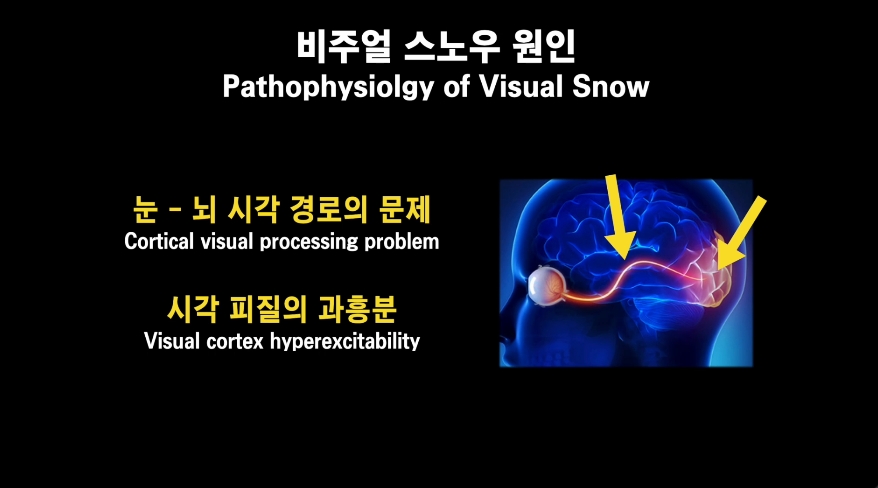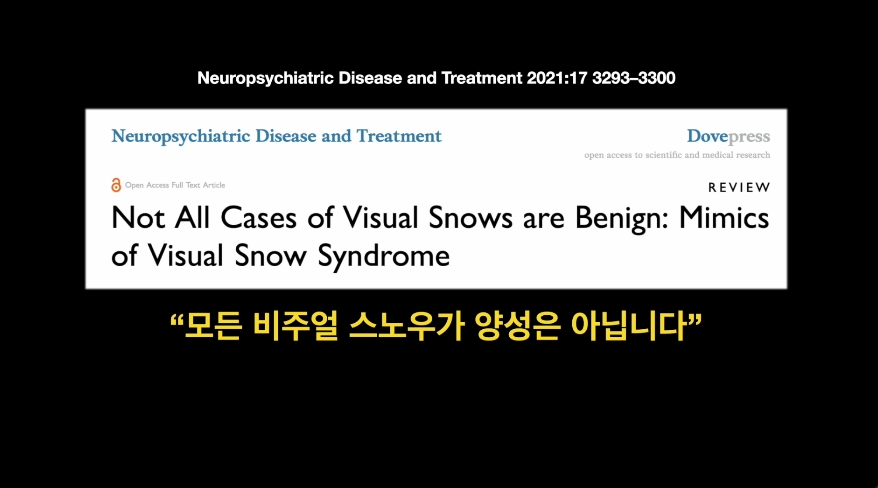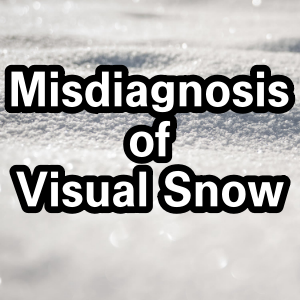Misdiagnosis of Visual Snow
“misdiagnosis of visual snow
Hello, I’m Dr. Song, your ophthalmologist.
It’s been a while since the concept of visual snow came out, but there are still many people who don’t know.
Even most doctors don’t know much about this concept…
However, unlike in the past, information exchange through the Internet has become more active.
And as access to medical information has become relatively easier, many people who suffer from visual snow symptoms can go to the hospital suspecting something strange.
However, the answer from most hospitals is that they don’t even know about such a disease, or simply that the basic test is normal, so it will be okay.
Is it really okay?

Today, we will have a time to summarize other diseases that can be misdiagnosed with Visual Snow.
If you suspect visual snow symptoms, we will also find out what flow to test.
There was a time when I covered it in a previous video, right?
I think other ophthalmologists should watch today’s video.
You can also watch the video on my YouTube channel below.
차례
What is Visual Snow?

As you know, the typical symptom of Visual Snow is
It is a symptom of noise appearing throughout the field of view as on the right. It also means that there are always these symptoms.

Visual snow symptoms were first reported in 1995, and the concept of “Visual Snow Syndrome” was not created until 2014.
Since then, studies have been conducted to find out the exact cause of the disease and find out effective treatments, and arestill ongoing.

The cause of visual snow has not yet been identified, but studies so far have shown that the cause of visual snow is
the problem of the route of visual information received from the eye to the brain,
the cortex, which is responsible for vision in the brain, is overly excited.
And it should not be another diseasethat can cause the above problems.
For example, a tumor in the brain may cause problems in the optic cortex or cause visual snow symptoms due to inflammation in the eyes.

In this case, removing the cause can improve the symptoms.
Conversely, even if it is misdiagnosed with Visual Snow and can be solved, it is not treated, or in the worst case, it is also possible to develop a causative disease.
Misdiagnosis of Visual Snow
So I’m going to review this paper today.

It is a paper published in the Journal of Neurology in November 2021, titled “Not all Visual Snow is benign.”
In other words, it is a paper on other diseases that can be misdiagnosed as Visual Snow.
Here is a list of other diseases that can cause visual snow symptoms.

Neurological disease
Ophthalmological disease
Drug-related side effects
Andsystemic disease.
Let’s focus on some of the representative things.
Neurological cuase

First of all, if you look at the neurological cause, all diseases that can affect the occipital lobe and the optic cortex of the brain are likely to cause visual snow symptoms.

Migraine,
occipital lobe disease,
degenerative brain diseases,
and brain trauma is typical
Migraine headaches share mechanisms very similar to visual snow syndrome, which can lead to delayed diagnosis or initial misdiagnosis.
Unlike Visual Snow, migraines have many different treatments and effective drugs.
Visual snow can also occur due to diseases that occur in the occipital lobe where the optic cortex exists.
There are epilepsy and cerebral infarction.
In the case of degenerative brain diseases, some rare diseases can cause visual snow.
In the case of occipital lobe disease and degenerative brain disease, the onset age is very late.
Visual snow symptoms can also occur if the visual path is damaged due to head injury.
It usually occurs within a few weeks after trauma.
Ophthalmological cause

Examples of ophthalmic diseases are retinal diseasesanduveitis, which causes inflammation of the uveitis.
All diseases that can occur in the retina, and posterior uveitis, an inflammatory form of the uveitis behind the retina, are all necessary.
Drug-related

Drug side effects are mainly side effects from drugs such as Extasi and methamphetamine, or illegal drugs, but various drugs such asantacids, antibiotics, anticancer drugs, and hormones commonly used in medicine can also induce visual symptoms such as Visual Snow.
Systemic disease

Related systemic diseases includecomplications after infection with systemic viral diseasessuch as colds and enteritis.
Hormonal changessuch as menstruation and pregnancy.
There are psychiatric diseases.
Diagnostic criteria of Visual Snow

Now, in order to diagnose visual snow, the following conditions are required.
Visual snow lasts more than three months throughout the field of view.
And you must have at least two symptoms of palinopsia, bluefield entoptic phenomenon, severe glare, and nyctalopia
And the most important thing. As I explained earlier, no organic cause should be found.
Visual Snow from these temperamental causes is also referred to as secondary visual snow.
Secondary Visual Snow

In the following cases, secondary visual snow may be more suspicious.
Late onset of Visual Snow.
Intermittent or sudden exacerbation of symptoms.
If only one eye or half of the field of vision has symptoms.
If there is a drug that you have recently stopped taking or started taking.
Case where other vision problems such as decreased vision and color vision are accompanied.
Finally, other neurological problems such as paralysis and muscle weakness are accompanied.
In these situations, it is necessary to differentiate other causes through additional tests.
Diagnostic algorithm of Visual Snow

If you look at a patient suspected of visual snow, first of all, ask about underlying diseases such as recent trauma or systemic diseases, and suspect that it is visual snow related to systemic diseases.
You should also check the drugs they have taken or are taking.
You can doubt and filter out a lot of things just by listening to medical history and asking questions.

The neurology and ophthalmology department will then conduct basic neurological and ophthalmic examinations.
Ophthalmologically, eye sight, color sense, fundus, and vision tests are included in the basic examination.

If the basic test is normal, it will be diagnosed as Visual Snow syndrome considering various other diagnostic criteria.

If there are abnormal findings in neurological tests, try to differentiate the cause through brain MRI or EEG.

If there were abnormal findings in the ophthalmic examination, all possible ophthalmic causative diseases should be distinguished through additional tests such as ERG or VEP tests.
Summary
So far, we have learned about diseases that can be misdiagnosed with Visual Snow and the process of diagnosing Visual Snow.
If you have only visual snow symptoms, not pure visual snow syndrome, that is, if you suspect secondary visual snow, you must identify the cause through a thorough examination.
Thank you for watching until the end.
I will visit again next time with useful information.
Please use the community for questions.

